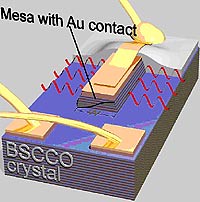
Schematic of the terahertz-source, which was fabricated on the top of an atomically layered superconducting crystal. The applied current excites the fundamental cavity mode (solid half-wave) on the width w of the mesa, and high-frequency electromagnetic radiation is emitted from the side faces (red waves).
Unlike far more energetic X-rays, T-rays do not have sufficient energy to “ionize” an atom by knocking loose one of its electrons. This ionization causes the cellular damage that can lead to radiation sickness or cancer. Since T-rays are non-ionizing radiation, like radio waves or visible light, people exposed to terahertz radiation will suffer no ill effects. Furthermore, although terahertz radiation does not penetrate through metals and water, it does penetrate through many common materials, such as leather, fabric, cardboard and paper.
These qualities make terahertz devices one of the most promising new technologies for airport and national security. Unlike today’s metal or X-ray detectors, which can identify only a few obviously dangerous materials, checkpoints that look instead at T-ray absorption patterns could not only detect but also identify a much wider variety of hazardous or illegal substances.
T-rays can also penetrate the human body by almost half a centimeter, and they have already begun to enable doctors to better detect and treat certain types of cancers, especially those of the skin and breast, Welp said. Dentists could also use T-rays to image their patients’ teeth.
Being able to produce a beam of ‘T-rays’ in that range could revolutionise airport security and medical scans. They have persuaded normally independent quantum junctions to work together. Welp and colleagues made hundreds of junctions work together, creating a beam of laser-like terahertz light with 10,000 times more power (about half a microwatt).
The team used a high-temperature semiconductor called BSCCO, which naturally contains stacks of Josephson junctions in its structure. It comprises of superconducting sheets, a couple of atoms thick, separated by 1.5 nanometer insulating gaps.
“We were able to pack in a huge number of Josephson junctions” in each crystal, Welp says. In a strip of the material about one micron tall, 100 microns wide, and 300 microns long, they fitted in more than 600 junctions.
“If the power output were boosted up to 1 to 10 milliwatts, it would be a very promising niche device”, complementing other devices that create terahertz radiation at other frequencies, Yergens says.
The frequencies covered by the new device are some of the more useful for imaging. “You have to be slightly below one terahertz to take full advantage of such radiation,” he adds.

Brian Wang is a Futurist Thought Leader and a popular Science blogger with 1 million readers per month. His blog Nextbigfuture.com is ranked #1 Science News Blog. It covers many disruptive technology and trends including Space, Robotics, Artificial Intelligence, Medicine, Anti-aging Biotechnology, and Nanotechnology.
Known for identifying cutting edge technologies, he is currently a Co-Founder of a startup and fundraiser for high potential early-stage companies. He is the Head of Research for Allocations for deep technology investments and an Angel Investor at Space Angels.
A frequent speaker at corporations, he has been a TEDx speaker, a Singularity University speaker and guest at numerous interviews for radio and podcasts. He is open to public speaking and advising engagements.

